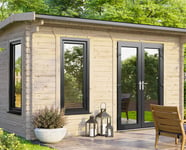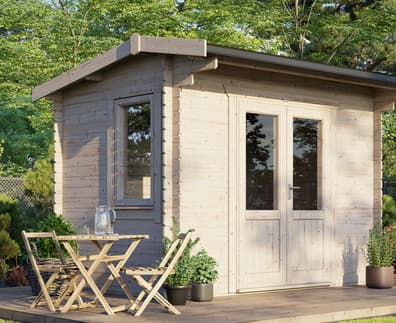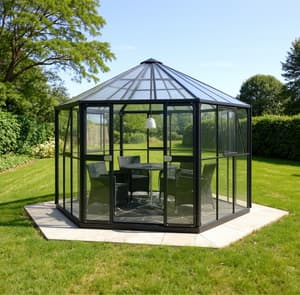
£10 OFF Everything!
Use code SUMMER10 at checkout min order £399 (Everything)
Garden Rooms
Garden Rooms UK
Garden Rooms for Sale Online with Free UK Home Delivery here at Greenhouse Stores. These aren't mere structures - they're living sanctuaries where work flows as naturally as seasons in your garden room studio, or where peace settles in your garden office like evening shadows. Our Garden Rooms emerge from the earth like well-tended perennials, each insulated garden room offering shelter through every weather's whisper.
For intimate gardens, our Small Garden Rooms nestle among beloved plants like precious gems, while our contemporary garden rooms dance with light through clean lines. Discover our Modern Garden Rooms that sing of innovation in garden serenity, and Insulated Garden Rooms that embrace you through frost-kissed mornings and balmy summer evenings alike. If you are looking to relax and take the weight of the world off your shoulders, we have a great range of Home Saunas to choose from.
Garden Rooms: Where Your Garden Meets Living Space
Garden Rooms for Sale Online with Free UK Home Delivery here at Greenhouse Stores. These aren't mere structures - they're living sanctuaries where work flows as naturally as seasons in your garden room studio, or where peace settles in your garden office like evening shadows. Our Garden Rooms emerge from the earth like well-tended perennials, each insulated garden room offering shelter through every weather's whisper.
For intimate gardens, our Small Garden Rooms nestle among beloved plants like precious gems, while our contemporary garden rooms dance with light through clean lines. Discover our Modern Garden Rooms that sing of innovation in garden serenity, and Insulated Garden Rooms that embrace you through frost-kissed mornings and balmy summer evenings alike. If you are looking to relax and take the weight of the world off your shoulders, we have a great range of Home Saunas to choose from.
Garden Rooms: Complete Guide to Outdoor Living Spaces in 2025
Key Takeaways
- Price Range: £2,914 - £15,999+
- Planning Permission: Generally not required under 2.5m height
- Delivery Time: 4-12 weeks typically
- Installation: Professional recommended
- Insulation: Available for year-round use
- Sizes Available: 8x8 to 20x18 feet
- Popular Uses: Home office, gym, studio, relaxation space
Garden Rooms: Your Garden's Hidden Potential
Garden rooms have completely changed how we think about outdoor spaces. I've watched countless homeowners go from having unused garden corners to creating their favourite room in the house. It's quite remarkable really.

These buildings aren't just fancy sheds - they're proper living spaces that happen to be in your garden. You can work in them, relax in them, exercise in them, or just escape from the kids for five minutes. The freedom is what makes them so appealing.
What's brilliant about garden rooms is how they solve the age-old problem of needing more space without the nightmare of house extensions. No planning committees arguing about your conservatory, no builders tramping through your kitchen for months, no neighbours complaining about the noise.
The construction has got much better over the years too. Gone are the days of glorified garden sheds that leaked when it rained. Modern garden rooms are built to last, with proper insulation, decent windows, and weatherproofing that actually works.
I've seen people use these buildings for everything imaginable:
- Home offices where you can actually concentrate
- Art studios with natural light that doesn't cost a fortune
- Gyms where nobody judges your workout playlist
- Reading nooks away from the TV noise
- Teenage hideaways (probably the most popular use!)
The best part? Once you've got one, you'll wonder how you ever managed without it. It's like having a secret weapon against household chaos.
Garden Rooms for Sale: What's Actually Worth Buying
The market's flooded with garden rooms these days, which is great for choice but terrible for decision-making. I've seen people spend hours scrolling through options, getting more confused with every click.

Let me break down what you're actually looking at when Browse garden rooms. You've got your Apex Garden Rooms with the traditional pointy roofs - they're good for water runoff and look quite classic. Then there's Pent Garden Rooms with sloping roofs that look more modern and suit contemporary gardens.
Here's what actually affects the price:
| What You're Paying For | Why It Matters |
|---|---|
| Size | Bigger = more materials = more money (obviously) |
| Wall Thickness | Thicker walls = warmer in winter = higher price |
| Proper Windows | Double glazing costs more but you'll thank yourself later |
| Real Insulation | Proper insulation vs. "insulation" - there's a difference |
| Roof Design | Fancy roofs cost more to build |
The truth is, you get what you pay for. I've seen too many people buy cheap garden rooms that turn into damp, cold boxes within a year. The cheapest option usually ends up being the most expensive once you factor in repairs and replacements.
Most decent suppliers will deliver within 10-12 weeks, often with free delivery if you're on the mainland. Some offer installation too - and honestly, unless you're particularly handy, it's worth paying for. Getting the foundations wrong can ruin the whole thing.
Look for FSC-certified timber (it's sustainably sourced) and a proper warranty. If they can't tell you where their wood comes from or won't guarantee their work, keep looking.
Garden Rooms UK: The Rules You Need to Know
Here's the thing about UK planning rules - they're actually quite reasonable when it comes to garden rooms. Most of the time, you won't need planning permission at all.

The magic numbers are 2.5m for flat roofs and 4m for pitched roofs. Stay under those heights and you're usually fine. The building can't take up more than half your garden either, but unless you've got a postage stamp garden, that's rarely an issue.
Here's how it works across the UK:
- England: Pretty straightforward - Permitted Development Rights cover most situations
- Scotland: Similar rules but double-check with your local council
- Wales: Same as England basically
- Northern Ireland: Different system entirely - definitely check first
The British weather is what really matters though. Our climate isn't kind to buildings that aren't properly built. Endless rain, frost, wind - it all takes its toll. UK suppliers understand this better than some foreign manufacturers who design for warmer, drier climates.
The garden room market's exploded since Covid. Everyone suddenly needed home offices, and traditional house extensions became impossible with social distancing. This meant longer waiting times but also more competition, which drove prices down.
Brexit did mess things up a bit. Some European suppliers stopped delivering here, but UK manufacturers stepped up. The quality's actually improved as British companies invested in better equipment and training.
Insulated Garden Rooms: Worth the Extra Cost?
Insulated garden rooms cost more upfront - sometimes double the price of basic models. But here's the thing: if you want to use your garden room in winter, proper insulation isn't optional.

Quality Insulated Garden Rooms include:
What proper insulation looks like:
- Walls: 100mm thick insulation minimum (not the thin stuff)
- Roof: Often the biggest heat loss area if done wrong
- Floor: Stops cold rising from the ground
- Windows: Double glazing that actually works
- No gaps: Continuous insulation without cold spots
I've worked in both types, and the difference is like night and day. In an uninsulated garden room in January, you're basically working in a slightly warmer shed. In a properly insulated one, you can wear normal clothes and actually think clearly.
The running costs are lower too. A small heater can keep a well-insulated garden room comfortable, whilst an uninsulated one needs constant heating and still feels cold.
Modern features worth considering:
- Underfloor heating - more comfortable than radiators
- Proper electrical setup - multiple sockets and good lighting
- Ventilation systems - stops condensation problems
- Smart controls - heat it up before you arrive
The payback period depends on how much you use it. If it's your daily office, insulation pays for itself within a year. If it's occasional use, maybe stick with a basic model.
Garden Room Installation: Don't Try This at Home
I've seen some spectacular DIY installation failures over the years. Garden rooms look simple enough - just bolt the bits together, right? Wrong.

What actually happens during installation:
- Ground work - This is where most DIY projects go wrong
- Foundations - Concrete pads or full bases (heavier than you think)
- Frame assembly - Needs to be square and level
- Roof work - Waterproofing is crucial
- Finishing - Doors, windows, trim work
The foundation bit is what trips people up. Your garden room weighs more than you think, especially once you've got furniture in it. The ground moves with the seasons too - clay soil can shift dramatically between wet and dry periods.
Timeline reality check:
- Simple buildings: 1-2 days with experienced installers
- Complex structures: Up to a week
- Weather problems: Can double the time
- Council inspections: Add extra days
Professional installation usually costs 10-20% of the building price. It's worth every penny for the peace of mind. Most suppliers offer it, and they know their own products best.
The warranty often depends on professional installation too. Try to install it yourself and you might void the guarantee. Then if something goes wrong, you're stuck with the repair costs.
Contemporary Garden Rooms: Modern Looks That Actually Work
Modern garden rooms have moved way beyond the traditional log cabin look. These days, they're designed to complement contemporary homes rather than look like they belong in a forest.

Modern Garden Rooms feature:
What makes them look contemporary:
- Massive windows - floor to ceiling glass panels
- Sliding doors - open the whole wall to your garden
- Clean lines - no fussy decorative bits
- Quality materials - cedar, composite panels, painted finishes
- Integrated lighting - built-in LED systems
The appeal is versatility. They work with modern houses, traditional properties, and everything in between. Neutral colours mean they won't clash with your garden design or look dated in five years.
Smart features people actually use:
- Automated blinds - privacy and light control
- Climate control - heating and cooling systems
- Built-in sound systems - for music or calls
- Security systems - cameras and alarms
- EV charging points - for electric cars
The interior design tends to be minimal. Clean lines, uncluttered spaces, neutral colours. It's calming and makes the space feel bigger. Perfect for offices or creative spaces where you need to concentrate.
One trend I've noticed is integrating outdoor features. Decking, pergolas, outdoor kitchens - they create a complete outdoor living area that extends beyond the building itself.
Small Garden Rooms: Big Impact, Small Footprint
Small garden rooms are brilliant for people who don't have acres of space but still want their own retreat. An 8x8 foot room might not sound like much, but it's surprising how functional they can be.

Why small works:
- Lower cost - obviously needs less material
- Easier installation - simpler foundations
- Planning friendly - more likely to meet regulations
- Urban suitable - fits in terraced house gardens
- Less maintenance - smaller surface area to look after
Small Garden Rooms need clever design to work properly. Every square foot counts, so you need to think carefully about what you actually need.
Making small spaces work:
- Built-in storage - wall-mounted shelving and cupboards
- Folding furniture - desks that fold away when not needed
- Light colours - makes the space feel bigger
- Good lighting - dark corners make spaces feel smaller
- Outdoor connection - big windows to the garden
Corner Garden Rooms are particularly clever. They fit into garden corners that are often wasted space. The angled walls can actually create interesting interior layouts too.
What works well in small spaces:
- Home offices - perfect for video calls and paperwork
- Art studios - great light and no interruptions
- Quiet spaces - somewhere to read or meditate
- Exercise rooms - private space for workouts
- Music rooms - practise without disturbing neighbours
The key is being realistic about what you need. A small, well-designed space beats a large, poorly planned one every time.
Large Garden Rooms: When You've Got Space to Fill
Large garden rooms are for people who want to do everything. At 20x18 feet, you're talking about serious space - bigger than many living rooms.

What you can fit in large spaces:
- Multiple zones - office area, relaxation area, storage
- Separate rooms - partition walls for privacy
- Kitchen facilities - sink, fridge, basic cooking
- Bathroom facilities - toilet and washing area
- Guest accommodation - somewhere for visitors to stay
The structural requirements are much more demanding. You need proper foundations, stronger frames, and careful attention to wind loading. Professional installation isn't optional - it's essential.
Popular large garden room uses:
- Guest houses - complete with bedroom and bathroom
- Teenage quarters - separate space for older kids
- Workshop spaces - room for tools and projects
- Entertainment areas - pool tables, home cinema
- Multi-generational living - space for elderly relatives
Advanced features that make sense:
- Separate entrances - different areas, different access
- Kitchenette - basic cooking without running to the house
- Bathroom - proper facilities for all-day use
- Zoned heating - different temperatures for different areas
- Outdoor terraces - extend the living space outside
The running costs are higher because you're heating and lighting more space. But they add serious value to your property. A well-designed large garden room can be worth more than the cost of installation.
Garden Offices: The Home Working Revolution
Garden offices have gone from niche to mainstream incredibly quickly. The pandemic showed millions of people what it was like to work from home, and many decided they never wanted to go back to commuting.

What makes a good garden office:
- Proper insulation - comfortable all year round
- Multiple power sockets - for computers, printers, equipment
- Strong internet - ethernet connection or excellent WiFi
- Good lighting - natural light plus task lighting
- Adequate storage - files, equipment, supplies
The psychology of separate workspace is powerful. Having a dedicated office helps you switch between work and home mode. It's easier to concentrate when you're not surrounded by domestic distractions.
Professional features worth considering:
- Heating system - efficient and controllable
- Ventilation - fresh air without draughts
- Security - locks, alarms, secure storage
- Soundproofing - for video calls and concentration
- Emergency kit - first aid, emergency contacts
The best garden offices are set up properly from day one. Trying to add heating, electrics, or insulation later is expensive and disruptive. It's worth investing in quality from the start.
Tax considerations:
HMRC allows some business expense claims for dedicated office spaces. The rules are complicated, so get professional advice if you're claiming. Keep detailed records of business use - they'll want proof.
Traditional Summerhouses can sometimes work as offices, but they usually need extra insulation and electrical work. Purpose-built garden offices are designed for year-round professional use.
Frequently Asked Questions
-
What is a garden room?
A garden room is a separate building in your garden that gives you extra living space. They're built as standalone structures and can be used for offices, studios, gyms, or just somewhere to escape.
-
Do you need Planning Permission to build a garden room?
Usually no. Most garden rooms fall under Permitted Development Rights. Keep it under 2.5m high (4m for pitched roofs) and under 50% of your garden area, and you should be fine. Always check with your local council though.
-
What is the 2.5m rule for garden rooms?
It's the maximum height allowed without planning permission. Measure from ground level to the highest point. Go over this and you'll need to apply for planning permission.
-
Can I put a toilet in my garden room?
Yes, but you'll need proper drainage and possibly building regulations approval. Factor in the cost of connecting to your sewage system - it's not cheap.
-
How to insulate a garden room?
Insulation goes in the walls, roof, and floor during construction. Use proper materials like mineral wool, make sure there are no gaps, and get it done professionally if you want it to work properly.
-
How to build a garden room?
You need proper foundations, frame construction, weatherproofing, and finishing. Most people should hire professionals - it's more complex than it looks, and mistakes are expensive.
-
How much does a garden room cost?
Anywhere from £2,914 for basic models to £15,999+ for premium buildings. Add installation, foundations, and electrical work on top. The cheap ones often end up costing more in the long run.
-
Do garden rooms add value?
Good ones do. A well-built garden room in the right location can add significant value to your property. The key is quality construction and appropriate design for your area.
-
How to decorate a garden room?
Think about how you'll use it, the lighting conditions, and potential moisture. Use materials that can handle temperature changes. Many people keep it simple and clean - it's more versatile that way.
























































